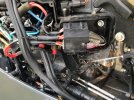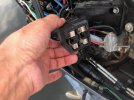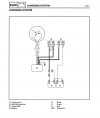- Joined
- Apr 23, 2019
- Messages
- 402
- Reaction score
- 79
- Points
- 28
- Age
- 70
- Model
- Marlin
Today was the first trip with new auto pilot and it was great, worked well until the low battery message came up. Today confirmed a problem I thought was occurring. The house battery is not being charged by the accessory charging leads from the motors. I have 3 batteries all new and good shape. 2 starting and 1 house. Both accessory charge leads go to house as yamaha rigging says. No problems with starting batteries, always around 13 volts and show charging is occurring when engines are running. There is no change in the house battery voltage when engines are running vs when powered off. When connected to shore power and on board charger running, all batteries show charging is occurring at 14+ volts. I am at a loss, pulled the cowl on one engine and the accessory lead is connected to what looks like a large black fuse block with 2 fuses which seem ok. Hoping someone can help me
thanks
thanks




